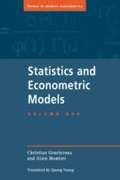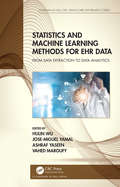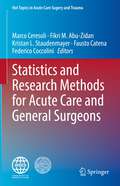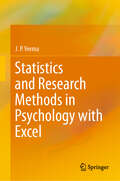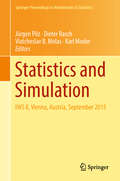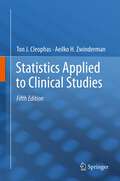- Table View
- List View
Statistics and Data with R: An Applied Approach Through Examples
by Yosef Cohen Jeremiah Y. CohenR, an Open Source software, has become the de facto statistical computing environment. It has an excellent collection of data manipulation and graphics capabilities. It is extensible and comes with a large number of packages that allow statistical analysis at all levels – from simple to advanced – and in numerous fields including Medicine, Genetics, Biology, Environmental Sciences, Geology, Social Sciences and much more. The software is maintained and developed by academicians and professionals and as such, is continuously evolving and up to date. Statistics and Data with R presents an accessible guide to data manipulations, statistical analysis and graphics using R. Assuming no previous knowledge of statistics or R, the book includes: A comprehensive introduction to the R language. An integrated approach to importing and preparing data for analysis, exploring and analyzing the data, and presenting results. Over 300 examples, including detailed explanations of the R scripts used throughout. Over 100 moderately large data sets from disciplines ranging from Biology, Ecology and Environmental Science to Medicine, Law, Military and Social Sciences. A parallel discussion of analyses with the normal density, proportions (binomial), counts (Poisson) and bootstrap methods. Two extensive indexes that include references to every R function (and its arguments and packages used in the book) and to every introduced concept.
Statistics And Econometric Models (Themes In Modern Econometrics Ser. (PDF))
by Christian Gourieroux Alain Monfort Quang Vuong Eric Ghysels Peter C. B. Phillips Richard J. SmithThis is the first volume in a major two-volume set of advanced texts in econometrics. It is essentially a text in statistics which is adapted to deal with economic phenomena. Christian Gourieroux and Alain Monfort have written a text which synthesises a great deal of material scattered across a variety of books and journals. They present both the basic and the more sophisticated statistical models which are crucial to an understanding of econometric models, and have taken care to employ mathematical tools with which a majority of students with a basic course in econometrics will be familiar. One of the most attractive features of the books is the liberal use throughout of real-world economic examples. They are also distinctive for their emphasis on promoting an intuitive understanding of the models and results at the expense of overly technical discussions.
Statistics And Econometric Models (Themes In Modern Econometrics Ser.(PDF))
by Christian Gourieroux Alain Monfort Quang Vuong Eric Ghysels Peter C. B. Phillips Richard J. SmithThis is the first volume in a major two-volume set of advanced texts in econometrics. It is essentially a text in statistics which is adapted to deal with economic phenomena. Christian Gourieroux and Alain Monfort have written a text which synthesises a great deal of material scattered across a variety of books and journals. They present both the basic and the more sophisticated statistical models which are crucial to an understanding of econometric models, and have taken care to employ mathematical tools with which a majority of students with a basic course in econometrics will be familiar. One of the most attractive features of the books is the liberal use throughout of real-world economic examples. They are also distinctive for their emphasis on promoting an intuitive understanding of the models and results at the expense of overly technical discussions.
Statistics And Econometric Models (Themes In Modern Econometrics Ser. (PDF))
by Christian Gourieroux Alain Monfort Quang Vuong Eric Ghysels Peter C. B. Phillips Richard J. SmithThis is the first volume in a major two-volume set of advanced texts in econometrics. It is essentially a text in statistics which is adapted to deal with economic phenomena. Christian Gourieroux and Alain Monfort have written a text which synthesises a great deal of material scattered across a variety of books and journals. They present both the basic and the more sophisticated statistical models which are crucial to an understanding of econometric models, and have taken care to employ mathematical tools with which a majority of students with a basic course in econometrics will be familiar. One of the most attractive features of the books is the liberal use throughout of real-world economic examples. They are also distinctive for their emphasis on promoting an intuitive understanding of the models and results at the expense of overly technical discussions.
Statistics and Finance: An Introduction (Springer Texts in Statistics)
by David RuppertThis book emphasizes the applications of statistics and probability to finance. The basics of these subjects are reviewed and more advanced topics in statistics, such as regression, ARMA and GARCH models, the bootstrap, and nonparametric regression using splines, are introduced as needed. The book covers the classical methods of finance and it introduces the newer area of behavioral finance. Applications and use of MATLAB and SAS software are stressed. The book will serve as a text in courses aimed at advanced undergraduates and masters students. Those in the finance industry can use it for self-study.
Statistics and Health Care Fraud: How to Save Billions (ASA-CRC Series on Statistical Reasoning in Science and Society)
by Tahir EkinStatistics and Health Care Fraud: How to Save Billions helps the public to become more informed citizens through discussions of real world health care examples and fraud assessment applications. The author presents statistical and analytical methods used in health care fraud audits without requiring any mathematical background. The public suffers from health care overpayments either directly as patients or indirectly as taxpayers, and fraud analytics provides ways to handle the large size and complexity of these claims. The book starts with a brief overview of global healthcare systems such as U.S. Medicare. This is followed by a discussion of medical overpayments and assessment initiatives using a variety of real world examples. The book covers subjects as: • Description and visualization of medical claims data • Prediction of fraudulent transactions • Detection of excessive billings • Revealing new fraud patterns • Challenges and opportunities with health care fraud analytics Dr. Tahir Ekin is the Brandon Dee Roberts Associate Professor of Quantitative Methods in McCoy College of Business, Texas State University. His previous work experience includes a working as a statistician on health care fraud detection. His scholarly work on health care fraud has been published in a variety of academic journals including International Statistical Review, The American Statistician, and Applied Stochastic Models in Business and Industry. He is a recipient of the Texas State University 2018 Presidential Distinction Award in Scholar Activities and the ASA/NISS y-Bis 2016 Best Paper Awards. He has developed and taught courses in the areas of business statistics, optimization, data mining and analytics. Dr. Ekin also serves as Vice President of the International Society for Business and Industrial Statistics.
Statistics and Health Care Fraud: How to Save Billions (ASA-CRC Series on Statistical Reasoning in Science and Society)
by Tahir EkinStatistics and Health Care Fraud: How to Save Billions helps the public to become more informed citizens through discussions of real world health care examples and fraud assessment applications. The author presents statistical and analytical methods used in health care fraud audits without requiring any mathematical background. The public suffers from health care overpayments either directly as patients or indirectly as taxpayers, and fraud analytics provides ways to handle the large size and complexity of these claims. The book starts with a brief overview of global healthcare systems such as U.S. Medicare. This is followed by a discussion of medical overpayments and assessment initiatives using a variety of real world examples. The book covers subjects as: • Description and visualization of medical claims data • Prediction of fraudulent transactions • Detection of excessive billings • Revealing new fraud patterns • Challenges and opportunities with health care fraud analytics Dr. Tahir Ekin is the Brandon Dee Roberts Associate Professor of Quantitative Methods in McCoy College of Business, Texas State University. His previous work experience includes a working as a statistician on health care fraud detection. His scholarly work on health care fraud has been published in a variety of academic journals including International Statistical Review, The American Statistician, and Applied Stochastic Models in Business and Industry. He is a recipient of the Texas State University 2018 Presidential Distinction Award in Scholar Activities and the ASA/NISS y-Bis 2016 Best Paper Awards. He has developed and taught courses in the areas of business statistics, optimization, data mining and analytics. Dr. Ekin also serves as Vice President of the International Society for Business and Industrial Statistics.
Statistics and its Applications: Platinum Jubilee Conference, Kolkata, India, December 2016 (Springer Proceedings in Mathematics & Statistics #244)
by Asis Kumar Chattopadhyay Gaurangadeb ChattopadhyayThis book discusses recent developments and the latest research in statistics and its applications, primarily in agriculture and industry, survey sampling and biostatistics, gathering articles on a wide variety of topics. Written by leading academics, scientists, researchers and scholars from around the globe to mark the platinum jubilee of the Department of Statistics, University of Calcutta in 2016, the book is a valuable resource for statisticians, aspiring researchers and professionals across educational levels and disciplines.
Statistics and Machine Learning Methods for EHR Data: From Data Extraction to Data Analytics (Chapman & Hall/CRC Healthcare Informatics Series)
by Hulin Wu Jose Miguel Yamal Ashraf Yaseen Vahed MaroufyThe use of Electronic Health Records (EHR)/Electronic Medical Records (EMR) data is becoming more prevalent for research. However, analysis of this type of data has many unique complications due to how they are collected, processed and types of questions that can be answered. This book covers many important topics related to using EHR/EMR data for research including data extraction, cleaning, processing, analysis, inference, and predictions based on many years of practical experience of the authors. The book carefully evaluates and compares the standard statistical models and approaches with those of machine learning and deep learning methods and reports the unbiased comparison results for these methods in predicting clinical outcomes based on the EHR data. Key Features: Written based on hands-on experience of contributors from multidisciplinary EHR research projects, which include methods and approaches from statistics, computing, informatics, data science and clinical/epidemiological domains. Documents the detailed experience on EHR data extraction, cleaning and preparation Provides a broad view of statistical approaches and machine learning prediction models to deal with the challenges and limitations of EHR data. Considers the complete cycle of EHR data analysis. The use of EHR/EMR analysis requires close collaborations between statisticians, informaticians, data scientists and clinical/epidemiological investigators. This book reflects that multidisciplinary perspective.
Statistics and Machine Learning Methods for EHR Data: From Data Extraction to Data Analytics (Chapman & Hall/CRC Healthcare Informatics Series)
by Hulin Wu Jose-Miguel Yamal Ashraf Yaseen Vahed MaroufyThe use of Electronic Health Records (EHR)/Electronic Medical Records (EMR) data is becoming more prevalent for research. However, analysis of this type of data has many unique complications due to how they are collected, processed and types of questions that can be answered. This book covers many important topics related to using EHR/EMR data for research including data extraction, cleaning, processing, analysis, inference, and predictions based on many years of practical experience of the authors. The book carefully evaluates and compares the standard statistical models and approaches with those of machine learning and deep learning methods and reports the unbiased comparison results for these methods in predicting clinical outcomes based on the EHR data. Key Features: Written based on hands-on experience of contributors from multidisciplinary EHR research projects, which include methods and approaches from statistics, computing, informatics, data science and clinical/epidemiological domains. Documents the detailed experience on EHR data extraction, cleaning and preparation Provides a broad view of statistical approaches and machine learning prediction models to deal with the challenges and limitations of EHR data. Considers the complete cycle of EHR data analysis. The use of EHR/EMR analysis requires close collaborations between statisticians, informaticians, data scientists and clinical/epidemiological investigators. This book reflects that multidisciplinary perspective.
Statistics and Measurement Concepts with OpenStat
by William MillerThis reference manual for the OpenStat software, an open-source software developed by William Miller, covers a broad spectrum of statistical methods and techniques. A unique feature is its compatibility with many other statistical programs. OpenStat users are researchers and students in the social sciences, education, or psychology, who benefit from the hands on approach to Statistics. During and upon completion of courses in Statistics or measurement, students and future researchers need a low cost computer program available to them, and OpenStat fills this void. The software is used in Statistics courses around the world with over 50,000 downloads per year. The manual covers all functions of the OpenStat software, including measurement, ANOVAS, regression analyses, simulations, product-moment and partial correlations, and logistic regression. The manual is an important learning tool that explains the Statistics behind the many analyses possible with the program and demonstrates these analyses.
Statistics and Probability Theory: In Pursuit of Engineering Decision Support (Topics in Safety, Risk, Reliability and Quality #18)
by Michael Havbro FaberThis book provides the reader with the basic skills and tools of statistics and probability in the context of engineering modeling and analysis. The emphasis is on the application and the reasoning behind the application of these skills and tools for the purpose of enhancing decision making in engineering. The purpose of the book is to ensure that the reader will acquire the required theoretical basis and technical skills such as to feel comfortable with the theory of basic statistics and probability. Moreover, in this book, as opposed to many standard books on the same subject, the perspective is to focus on the use of the theory for the purpose of engineering model building and decision making. This work is suitable for readers with little or no prior knowledge on the subject of statistics and probability.
Statistics and Probability with Applications for Engineers and Scientists
by Bhisham C. Gupta Irwin GuttmanIntroducing the tools of statistics and probability from the ground up An understanding of statistical tools is essential for engineers and scientists who often need to deal with data analysis over the course of their work. Statistics and Probability with Applications for Engineers and Scientists walks readers through a wide range of popular statistical techniques, explaining step-by-step how to generate, analyze, and interpret data for diverse applications in engineering and the natural sciences. Unique among books of this kind, Statistics and Probability with Applications for Engineers and Scientists covers descriptive statistics first, then goes on to discuss the fundamentals of probability theory. Along with case studies, examples, and real-world data sets, the book incorporates clear instructions on how to use the statistical packages Minitab® and Microsoft® Office Excel® to analyze various data sets. The book also features: • Detailed discussions on sampling distributions, statistical estimation of population parameters, hypothesis testing, reliability theory, statistical quality control including Phase I and Phase II control charts, and process capability indices • A clear presentation of nonparametric methods and simple and multiple linear regression methods, as well as a brief discussion on logistic regression method • Comprehensive guidance on the design of experiments, including randomized block designs, one- and two-way layout designs, Latin square designs, random effects and mixed effects models, factorial and fractional factorial designs, and response surface methodology • A companion website containing data sets for Minitab and Microsoft Office Excel, as well as JMP ® routines and results Assuming no background in probability and statistics, Statistics and Probability with Applications for Engineers and Scientists features a unique, yet tried-and-true, approach that is ideal for all undergraduate students as well as statistical practitioners who analyze and illustrate real-world data in engineering and the natural sciences.
Statistics and Probability with Applications for Engineers and Scientists
by Bhisham C. Gupta Irwin GuttmanIntroducing the tools of statistics and probability from the ground up An understanding of statistical tools is essential for engineers and scientists who often need to deal with data analysis over the course of their work. Statistics and Probability with Applications for Engineers and Scientists walks readers through a wide range of popular statistical techniques, explaining step-by-step how to generate, analyze, and interpret data for diverse applications in engineering and the natural sciences. Unique among books of this kind, Statistics and Probability with Applications for Engineers and Scientists covers descriptive statistics first, then goes on to discuss the fundamentals of probability theory. Along with case studies, examples, and real-world data sets, the book incorporates clear instructions on how to use the statistical packages Minitab® and Microsoft® Office Excel® to analyze various data sets. The book also features: • Detailed discussions on sampling distributions, statistical estimation of population parameters, hypothesis testing, reliability theory, statistical quality control including Phase I and Phase II control charts, and process capability indices • A clear presentation of nonparametric methods and simple and multiple linear regression methods, as well as a brief discussion on logistic regression method • Comprehensive guidance on the design of experiments, including randomized block designs, one- and two-way layout designs, Latin square designs, random effects and mixed effects models, factorial and fractional factorial designs, and response surface methodology • A companion website containing data sets for Minitab and Microsoft Office Excel, as well as JMP ® routines and results Assuming no background in probability and statistics, Statistics and Probability with Applications for Engineers and Scientists features a unique, yet tried-and-true, approach that is ideal for all undergraduate students as well as statistical practitioners who analyze and illustrate real-world data in engineering and the natural sciences.
Statistics and Probability with Applications for Engineers and Scientists
by Bhisham C. Gupta Irwin Guttman Kalanka P. JayalathIntroduces basic concepts in probability and statistics to data science students, as well as engineers and scientists Aimed at undergraduate/graduate-level engineering and natural science students, this timely, fully updated edition of a popular book on statistics and probability shows how real-world problems can be solved using statistical concepts. It removes Excel exhibits and replaces them with R software throughout, and updates both MINITAB and JMP software instructions and content. A new chapter discussing data mining—including big data, classification, machine learning, and visualization—is featured. Another new chapter covers cluster analysis methodologies in hierarchical, nonhierarchical, and model based clustering. The book also offers a chapter on Response Surfaces that previously appeared on the book’s companion website. Statistics and Probability with Applications for Engineers and Scientists using MINITAB, R and JMP, Second Edition is broken into two parts. Part I covers topics such as: describing data graphically and numerically, elements of probability, discrete and continuous random variables and their probability distributions, distribution functions of random variables, sampling distributions, estimation of population parameters and hypothesis testing. Part II covers: elements of reliability theory, data mining, cluster analysis, analysis of categorical data, , nonparametric tests, simple and multiple linear regression analysis, analysis of variance, factorial designs, response surfaces, and statistical quality control (SQC) including phase I and phase II control charts. The appendices contain statistical tables and charts and answers to selected problems. Features two new chapters—one on Data Mining and another on Cluster Analysis Now contains R exhibits including code, graphical display, and some results MINITAB and JMP have been updated to their latest versions Emphasizes the p-value approach and includes related practical interpretations Offers a more applied statistical focus, and features modified examples to better exhibit statistical concepts Supplemented with an Instructor's-only solutions manual on a book’s companion website Statistics and Probability with Applications for Engineers and Scientists using MINITAB, R and JMP is an excellent text for graduate level data science students, and engineers and scientists. It is also an ideal introduction to applied statistics and probability for undergraduate students in engineering and the natural sciences.
Statistics and Probability with Applications for Engineers and Scientists Using MINITAB, R and JMP
by Bhisham C. Gupta Irwin Guttman Kalanka P. JayalathIntroduces basic concepts in probability and statistics to data science students, as well as engineers and scientists Aimed at undergraduate/graduate-level engineering and natural science students, this timely, fully updated edition of a popular book on statistics and probability shows how real-world problems can be solved using statistical concepts. It removes Excel exhibits and replaces them with R software throughout, and updates both MINITAB and JMP software instructions and content. A new chapter discussing data mining—including big data, classification, machine learning, and visualization—is featured. Another new chapter covers cluster analysis methodologies in hierarchical, nonhierarchical, and model based clustering. The book also offers a chapter on Response Surfaces that previously appeared on the book’s companion website. Statistics and Probability with Applications for Engineers and Scientists using MINITAB, R and JMP, Second Edition is broken into two parts. Part I covers topics such as: describing data graphically and numerically, elements of probability, discrete and continuous random variables and their probability distributions, distribution functions of random variables, sampling distributions, estimation of population parameters and hypothesis testing. Part II covers: elements of reliability theory, data mining, cluster analysis, analysis of categorical data, nonparametric tests, simple and multiple linear regression analysis, analysis of variance, factorial designs, response surfaces, and statistical quality control (SQC) including phase I and phase II control charts. The appendices contain statistical tables and charts and answers to selected problems. Features two new chapters—one on Data Mining and another on Cluster Analysis Now contains R exhibits including code, graphical display, and some results MINITAB and JMP have been updated to their latest versions Emphasizes the p-value approach and includes related practical interpretations Offers a more applied statistical focus, and features modified examples to better exhibit statistical concepts Supplemented with an Instructor's-only solutions manual on a book’s companion website Statistics and Probability with Applications for Engineers and Scientists using MINITAB, R and JMP is an excellent text for graduate level data science students, and engineers and scientists. It is also an ideal introduction to applied statistics and probability for undergraduate students in engineering and the natural sciences.
Statistics and Probability with Applications Teachers Edition
by Daren Starnes josh taborStatistics and Probability with Applications, Third Edition is the only introductory statistics text written by high school teachers for high school teachers and students. Daren Starnes, Josh Tabor, and the extended team of contributors bring their in-depth understanding of statistics and the challenges faced by high school students and teachers to development of the text and its accompanying suite of print and interactive resources for learning and instruction.A complete re-envisioning of the authors’ Statistics Through Applications, this new text covers the core content for the course in a series of brief, manageable lessons, making it easy for students and teachers to stay on pace. Throughout, new pedagogical tools and lively real-life examples help captivate students and prepare them to use statistics in college courses and in any career.
Statistics And The Quest For Quality Journalism (PDF): A Study In Quantitative Reporting
by Alessandro Martinisi Jairo Alfonso Lugo-OcandoThis book looks at how numbers and statistics have been used to underpin quality in news reporting. In doing so, the aim is to challenge some common assumptions about how journalists engage and use statistics in their quest for quality news. It seeks to improve our understanding about the usage of data and statistics as a primary means for the construction of social reality. This is a task, in our view, that is urgent in times of 'post-truth' politics and the rise of 'fake news'. In this sense, the quest to produce 'quality' news, which seems to require incorporating statistics and engaging with data, as laudable and straightforward as it sounds, is instead far more problematic and complex than what is often accounted for.
Statistics and Research Methods for Acute Care and General Surgeons (Hot Topics in Acute Care Surgery and Trauma)
by Marco Ceresoli Fikri M. Abu-Zidan Kristan L. Staudenmayer Fausto Catena Federico CoccoliniThe main aim of this book is to offer an easy tool to read a scientific article with greater awareness, to understand and evaluate it more thoroughly, and to better plan research. Today, in the era of evidence-based medicine, both research and daily patient-focused clinical practice are no longer possible without a thorough knowledge of the literature and its continuous updates.Written by surgeons for surgeons, this practical book makes the basic concept of statistics and research methodology easy to understand and apply for young surgeons and researchers, students and residents.
Statistics and Research Methods in Psychology with Excel
by J.P. VermaThis book, specifically developed for students of psychology, covers a wide range of topics in statistics and research designs taught in psychology, in particular, and other disciplines like management, sociology, education, home science, and nutrition, in general, in most universities. It explains how to use Excel to analyze research data by elaborating statistical concepts. Each chapter contains sections like “Check you Computing skill” and “Check your Statistical Concepts” to enable students to assess their knowledge in a graded manner. The book addresses one of the major challenges in psychology research, viz., how to measure subjective phenomenon like attitude, desire, and preferences of an individual. Separate emphasis has been given to the measurement techniques which are essential tools to assess these subjective parameters in numerical form, required for statistical analysis to draw meaningful conclusions. The book is equally helpful to students of humanities, life sciences and other applied areas. Consisting of 14 chapters, the book covers all relevant topics of statistics and research designs which are important for students to plan and complete their research work.
Statistics and Simulation: IWS 8, Vienna, Austria, September 2015 (Springer Proceedings in Mathematics & Statistics #231)
by Jürgen Pilz Dieter Rasch Viatcheslav B. Melas Karl ModerThis volume features original contributions and invited review articles on mathematical statistics, statistical simulation and experimental design. The selected peer-reviewed contributions originate from the 8th International Workshop on Simulation held in Vienna in 2015. The book is intended for mathematical statisticians, Ph.D. students and statisticians working in medicine, engineering, pharmacy, psychology, agriculture and other related fields.The International Workshops on Simulation are devoted to statistical techniques in stochastic simulation, data collection, design of scientific experiments and studies representing broad areas of interest. The first 6 workshops took place in St. Petersburg, Russia, in 1994 – 2009 and the 7th workshop was held in Rimini, Italy, in 2013.
Statistics and the Evaluation of Evidence for Forensic Scientists (Statistics in Practice)
by Colin Aitken Franco TaroniThe first edition of Statistics and the Evaluation of Evidence for Forensic Scientists established itself as a highly regarded authority on this area. Fully revised and updated, the second edition provides significant new material on areas of current interest including: Glass Interpretation Fibres Interpretation Bayes’ Nets The title presents comprehensive coverage of the statistical evaluation of forensic evidence. It is written with the assumption of a modest mathematical background and is illustrated throughout with up-to-date examples from a forensic science background. The clarity of exposition makes this book ideal for all forensic scientists, lawyers and other professionals in related fields interested in the quantitative assessment and evaluation of evidence. 'There can be no doubt that the appreciation of some evidence in a court of law has been greatly enhanced by the sound use of statistical ideas and one can be confident that the next decade will see further developments, during which time this book will admirably serve those who have cause to use statistics in forensic science.' D.V. Lindley
Statistics and the Evaluation of Evidence for Forensic Scientists (Statistics in Practice)
by Colin Aitken Franco Taroni Silvia BozzaThe leading resource in the statistical evaluation and interpretation of forensic evidence The third edition of Statistics and the Evaluation of Evidence for Forensic Scientists is fully updated to provide the latest research and developments in the use of statistical techniques to evaluate and interpret evidence. Courts are increasingly aware of the importance of proper evidence assessment when there is an element of uncertainty. Because of the increasing availability of data, the role of statistical and probabilistic reasoning is gaining a higher profile in criminal cases. That’s why lawyers, forensic scientists, graduate students, and researchers will find this book an essential resource, one which explores how forensic evidence can be evaluated and interpreted statistically. It’s written as an accessible source of information for all those with an interest in the evaluation and interpretation of forensic scientific evidence. Discusses the entire chain of reasoning–from evidence pre-assessment to court presentation; Includes material for the understanding of evidence interpretation for single and multiple trace evidence; Provides real examples and data for improved understanding. Since the first edition of this book was published in 1995, this respected series has remained a leading resource in the statistical evaluation of forensic evidence. It shares knowledge from authors in the fields of statistics and forensic science who are international experts in the area of evidence evaluation and interpretation. This book helps people to deal with uncertainty related to scientific evidence and propositions. It introduces a method of reasoning that shows how to update beliefs coherently and to act rationally. In this edition, readers can find new information on the topics of elicitation, subjective probabilities, decision analysis, and cognitive bias, all discussed in a Bayesian framework.
Statistics and the Evaluation of Evidence for Forensic Scientists (Statistics in Practice)
by Colin Aitken Franco Taroni Silvia BozzaThe leading resource in the statistical evaluation and interpretation of forensic evidence The third edition of Statistics and the Evaluation of Evidence for Forensic Scientists is fully updated to provide the latest research and developments in the use of statistical techniques to evaluate and interpret evidence. Courts are increasingly aware of the importance of proper evidence assessment when there is an element of uncertainty. Because of the increasing availability of data, the role of statistical and probabilistic reasoning is gaining a higher profile in criminal cases. That’s why lawyers, forensic scientists, graduate students, and researchers will find this book an essential resource, one which explores how forensic evidence can be evaluated and interpreted statistically. It’s written as an accessible source of information for all those with an interest in the evaluation and interpretation of forensic scientific evidence. Discusses the entire chain of reasoning–from evidence pre-assessment to court presentation; Includes material for the understanding of evidence interpretation for single and multiple trace evidence; Provides real examples and data for improved understanding. Since the first edition of this book was published in 1995, this respected series has remained a leading resource in the statistical evaluation of forensic evidence. It shares knowledge from authors in the fields of statistics and forensic science who are international experts in the area of evidence evaluation and interpretation. This book helps people to deal with uncertainty related to scientific evidence and propositions. It introduces a method of reasoning that shows how to update beliefs coherently and to act rationally. In this edition, readers can find new information on the topics of elicitation, subjective probabilities, decision analysis, and cognitive bias, all discussed in a Bayesian framework.
Statistics Applied to Clinical Studies
by Ton J. Cleophas Aeilko H. ZwindermanThanks to the omnipresent computer, current statistics can include data files of many thousands of values, and can perform any exploratory analysis in less than seconds. This development, however fascinating, generally does not lead to simple results. We should not forget that clinical studies are, mostly, for confirming prior hypotheses based on sound arguments, and the simplest tests provide the best power and are adequate for such studies. In the past few years the authors of this 5th edition, as teachers and research supervisors in academic and top-clinical facilities, have been able to closely observe the latest developments in the field of clinical data analysis, and they have been able to assess their performance. In this 5th edition the 47 chapters of the previous edition have been maintained and upgraded according to the current state of the art, and 20 novel chapters have been added after strict selection of the most valuable and promising novel methods. The novel methods are explained using practical examples and step-by-step analyses readily accessible for non-mathematicians. All of the novel chapters have been internationally published by the authors in peer-reviewed journal, including the American Journal of Therapeutics, the European Journal of Clinical Investigation, The International journal of Clinical Pharmacology and therapeutics, and other journals, and permission is granted by all of them to use this material in the current book. We should add that the authors are well-qualified in their fields of knowledge. Professor Zwinderman is president-elect of the International Society of Biostatistics, and Professor Cleophas is past-president of the American College of Angiology. From their expertise they should be able to make adequate selections of modern methods for clinical data analysis for the benefit of physicians, students, and investigators. The authors, although from a different discipline, one clinician and one statistician, have been working and publishing together for over 10 years, and their research of statistical methodology can be characterized as a continued effort to demonstrate that statistics is not mathematics but rather a discipline at the interface of biology and mathematics. They firmly believe that any reader can benefit from this clinical approach to statistical data analysis.

